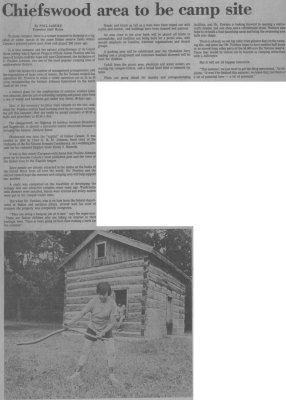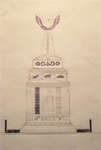"Chiefswood Area to be Camp Site"
- Publication
- Brantford Expositor, 12 Jul 1975
- Full Text
- Chiefswood area to be camp siteBy PAUL LaDUKE, Expositor Staff Writer
To many campers, there is a certain romance to sleeping in a log cabin or under canvas in the same Indian reserve fields where Canada's greatest native poet lived and played 200 years ago.
It is that romance and the natural attractiveness of its Grand River setting which Special Projects Officers James Powless and his team of Indian students hope will turn Chiefswood, the birthplace of E. Pauline Johnson, into one of the most popular camping sites in southwestern Ontario.
After the failure of a number of management arrangements, and the expenditure of large sums of money, the Six Nations council has appointed Mr. Powless to make a viable operation out of 25 to 30 acres incorporating the historic Johnson homestead on the north bank of the river.
A federal grant for the employment of summer student labor was obtained, and the job of exhuming camping and picnic sites from a sea of weeds and burdocks got under way about 10 days ago.
Most of the necessary facilities were already on the site, and, while Mr. Powless and his hard-working crew do not expect to finish the job this summer, they are ready to accept campers at $2.50 a night and picnickers at $1.50 a day.
The campground, on Highway 54 halfway between Brantford and Hagersville, is already a successful tourist attraction because it includes the historic Johnson home.
Chiefswood was once the "capital" of Indian Canada. It was erected in 1853 by Chief G. H. M. Johnson, head chief of the Mohawks of the Six Nations Iroquois Confederacy, as a wedding present for his cultured English bride Emily S. Howells.
It was in this stately European-style home that Pauline Johnson grew up to become Canada's most published poet and the voice of the Indian race in the English tongue.
Since people are already attracted to the estate on the banks of the Grand River from all over the world, Mr. Powless and the elected council hope the museum and camping area will help support one another.
A study was completed on the feasibility of developing the acreage into one attractive complex some years ago. Washrooms with showers were installed, fences were erected and utility outlets were put in for camper-trailer units.
But when Mr. Powless, who is on loan from the federal department of Indian and northern affairs, arrived with his crew of students the property was completely overgrown.
"They are doing a bang-up job of it now," says the supervisor. "These are Indian children who are taking an interest in their heritage, here. There is more going on here than making a buck for the summer"
Weeds and brush as tall as a man have been wiped out with scythe and tractor, and buildings have been cleaned and painted.
An area close the river bank will be placed off limits to automobiles, and facilities are being built for a picnic area, with special emphasis on families, fraternal organizations and church group groups.
A parking area will be established near the Ohsweken ferry landing and a playground and miniature baseball diamond will be built for children.
Uphill from the picnic area, electrical and water outlets are waiting for camper-trailers, and a broad level field is trimmed for tents.
Plans are going ahead for laundry and sewage-dumping facilities, and Mr. Powless is looking forward to opening a native-crafts display and sale shop and a refreshment stand. Workers also hope to re-build a boat-launching ramp and bring the swimming area back into shape.
There is already on old log cabin from pioneer days on the camping site, and some day Mr. Powless hopes to have another half dozen or so moved from other parts of the 50,000 acre Six Nations reserve. There they would be rented out to tourists as camping attractions with a difference.
But it will not all happen tomorrow.
"This summer, we just want to get the thing operational," he explains. "It won't be finished this summer; we know that, but there is a lot of potential here - a lot of potential."
- Creators
- La Duke, Paul, Author
- Menzies, Ray, Photographer
- Media Type
- Newspaper
- Publication
- Item Types
- Articles
- Clippings
- Description
- "After the failure of a number of management arrangements, and the expenditure of large sums of money, the Six Nations council has appointed Mr. Powless to make a viable operation out of 25 to 30 acres incorporating the historic Johnson homestead on the north bank of the river."
- Publisher
- Brantford Expositor
- Place of Publication
- Brantford, ON
- Date of Publication
- 12 Jul 1975
- Subject(s)
- Personal Name(s)
- Johnson, E. Pauline ; Powless, James ; Johnson, Emily S. H. ; Van Every, Cindy ; Martin, Debra ; Van Every, Pauline ; Douglas, Robert ; Isaacs, Gary.
- Corporate Name(s)
- Chiefswood Museum ; Six Nations Elected Band Council ; Haudenosaunee Confederacy Chiefs Council ; Government of Canada.
- Local identifier
- SNPL002245v00d
- Language of Item
- English
- Geographic Coverage
-
-
Ontario, Canada
Latitude: 43.098780847265 Longitude: -80.0958364654541
-
- Creative Commons licence
 [more details]
[more details]- Copyright Statement
- Public domain: Copyright has expired according to Canadian law. No restrictions on use.
- Copyright Date
- 1975
- Copyright Holder
- Brantford Expositor
- Contact
- Six Nations Public LibraryEmail:info@snpl.ca
Website:
Agency street/mail address:1679 Chiefswood Rd
PO Box 149
Ohsweken, ON N0A 1M0
519-445-2954



